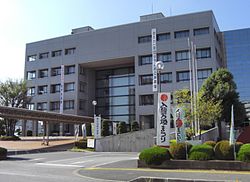Iruma (入間市, Iruma-shi) is a city located in Saitama Prefecture, Japan. As of 1 January 2021[update], the city had an estimated population of 147,166 in 66,516 households and a population density of 3,300 inhabitants per square kilometre (8,500/sq mi).[1] The total area of the city is 44.69 square kilometres (17.25 sq mi).
Iruma
入間市 | |
|---|---|
 Iruma City Hall | |
 Location of Iruma in Saitama Prefecture | |
| Coordinates: 35°50′8.9″N 139°23′28.1″E / 35.835806°N 139.391139°E | |
| Country | Japan |
| Region | Kantō |
| Prefecture | Saitama |
| Government | |
| • Mayor | Richirō Sugiyama (from November 2020) |
| Area | |
| • Total | 44.69 km2 (17.25 sq mi) |
| Population (January 2021) | |
| • Total | 147,166 |
| • Density | 3,300/km2 (8,500/sq mi) |
| Time zone | UTC+9 (Japan Standard Time) |
| - Tree | Zelkova serrata |
| - Flower | Camellia sinensis |
| - Bird | Eurasian skylark |
| Phone number | 04-2964-1111 |
| Address | 1-16-1 Toyooka, Iruma-shi, Saitama-ken 358-8511 |
| Website | Official website |


Geography
editLocated in the Sayama Highlands of far southern Saitama Prefecture, Iruma is bordered by Tokyo to the south. The Iruma River flows through the city.
Surrounding municipalities
editClimate
editIruma has a humid subtropical climate (Köppen: Cfa) characterized by warm summers and cool winters with light to no snowfall. The average annual temperature in Iruma is 14.1 °C (57.4 °F). The average annual rainfall is 1,481 mm (58.3 in) with September as the wettest month. The temperatures are highest on average in August, at around 25.9 °C (78.6 °F), and lowest in January, at around 3.2 °C (37.8 °F).[2]
Demographics
editPer Japanese census data,[3] the population of Iruma has recently plateaued after several decades of strong growth.
| Year | Pop. | ±% |
|---|---|---|
| 1960 | 36,903 | — |
| 1970 | 65,639 | +77.9% |
| 1980 | 104,034 | +58.5% |
| 1990 | 137,585 | +32.3% |
| 2000 | 147,909 | +7.5% |
| 2010 | 149,872 | +1.3% |
| 2020 | 145,671 | −2.8% |
History
editThe area around Iruma was part of ancient Musashi Province and was noted for kilns producing Sue ware pottery in the Nara period and Heian period. During the Edo period, the area developed as a series of three post towns on the Nikkō Wakiōkan highway during the Edo period. The town of Toyooka and villages of Kaneko, Miyadera, Fujisawa and Higashikaneko were created within Iruma District, Saitama with the establishment of the modern municipalities system on April 1, 1889. The Imperial Japanese Army Air Academy established an airfield in the area in 1938, which later developed into Iruma Air Base. On April 1, 1954, Higashikaneko became Seibu Town. On September 30, 1956, Toyooka, Kaneko, Miyadera, Fujisawa and Seibu merged to form the town of Musashi. Musashi was elevated to city status on November 1, 1966, becoming the city of Iruma. Discussions to merge with the neighboring city of Sayama in 2005 failed to pass a referendum. In 2017 Japan became the first country ever to elect an openly transgender man to any public office when Tomoya Hosoda was elected as a councillor for the city of Iruma.[4][5]
Government
editIruma has a mayor-council form of government with a directly elected mayor and a unicameral city council of 22 members. Iruma contributes two members to the Saitama Prefectural Assembly. In terms of national politics, the city is part of Saitama 9th district of the lower house of the Diet of Japan.
Economy
editIruma has a mixed economy with numerous industrial parks for light manufacturing and also serves as a regional commercial center. Due to its location, it is also a bedroom community for people commuting to the Tokyo metropolis for work. In terms of agriculture, Iruma and neighboring Sayama are famous for the green tea they produce.
Education
edit- Musashino Academia Musicae – Iruma campus
- Iruma 16 public elementary schools and 11 public middle schools operated by the city government, and two public high schools operated by the Saitama Prefectural Board of Education. In addition, there is one combined private middle/high school and three private high schools. The prefecture also operates one special education school.
Transportation
editRailway
editSeibu Railway - Seibu Ikebukuro Line
- Musashi-Fujisawa --- Irumashi - Bushi - Motokaji
Highway
editMilitary facilities
edit- Iruma Air Base, located in Iruma and neighboring the city of Sayama is a facility of the Japan Air Self-Defense Force. The base holds an open house annually in early November. This airbase was formerly known as Johnson Air Base while under the control of the United States Air Force.
Sister cities
editIruma is twinned with:
- Sado, Niigata, Japan, since 1986
- Wolfratshausen, Germany, since October 14, 1987[6]
- Fenghua, Zhejiang, China, friendship city since May 16, 2000[6]
Local attractions
edit- Iruma City Museum
Notable people
edit- Chihana Hara, rhythmic gymnast
- Keisuke Ishii, professional wrestler
- Wataru Kozuki, Takarazuka performer
- Yūsei Matsui, manga artist
- Junpei Yasuda, journalist
References
edit- ^ "Iruma city official statistics" (PDF) (in Japanese). Japan. Archived from the original (PDF) on 2022-07-05. Retrieved 2021-02-03.
- ^ Iruma climate data
- ^ Iruma population statistics
- ^ Chloe Farand. "Japan becomes first country in the world to elect a transgender man to a public office". The Independent. Retrieved 2017-03-18.
- ^ "Japan just elected its first trans man into public office · PinkNews". Pinknews.co.uk. Retrieved 2017-03-18.
- ^ a b "International Exchange". List of Affiliation Partners within Prefectures. Council of Local Authorities for International Relations (CLAIR). Archived from the original on 4 January 2016. Retrieved 21 November 2015.
External links
edit- Official Website (in Japanese)


